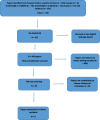How do patient reported outcome measures (PROMs) support clinician-patient communication and patient care? A realist synthesis
- PMID: 30294712
- PMCID: PMC6153194
- DOI: 10.1186/s41687-018-0061-6
How do patient reported outcome measures (PROMs) support clinician-patient communication and patient care? A realist synthesis
Abstract
Background: In this paper, we report the findings of a realist synthesis that aimed to understand how and in what circumstances patient reported outcome measures (PROMs) support patient-clinician communication and subsequent care processes and outcomes in clinical care. We tested two overarching programme theories: (1) PROMs completion prompts a process of self-reflection and supports patients to raise issues with clinicians and (2) PROMs scores raise clinicians' awareness of patients' problems and prompts discussion and action. We examined how the structure of the PROM and care context shaped the ways in which PROMs support clinician-patient communication and subsequent care processes.
Results: PROMs completion prompts patients to reflect on their health and gives them permission to raise issues with clinicians. However, clinicians found standardised PROMs completion during patient assessments sometimes constrained rather than supported communication. In response, clinicians adapted their use of PROMs to render them compatible with the ongoing management of patient relationships. Individualised PROMs supported dialogue by enabling the patient to tell their story. In oncology, PROMs completion outside of the consultation enabled clinicians to identify problematic symptoms when the PROM acted as a substitute rather than addition to the clinical encounter and when the PROM focused on symptoms and side effects, rather than health related quality of life (HRQoL). Patients did not always feel it was appropriate to discuss emotional, functional or HRQoL issues with doctors and doctors did not perceive this was within their remit.
Conclusions: This paper makes two important contributions to the literature. First, our findings show that PROMs completion is not a neutral act of information retrieval but can change how patients think about their condition. Second, our findings reveal that the ways in which clinicians use PROMs is shaped by their relationships with patients and professional roles and boundaries. Future research should examine how PROMs completion and feedback shapes and is influenced by the process of building relationships with patients, rather than just their impact on information exchange and decision making.
Keywords: Clinician-patient communication; Feedback; Patient reported outcome measures; Realist synthesis.
Conflict of interest statement
Our review did not require that we collected data from human subjects. NHS managers, clinicians and patients helped shape the focus of the review through workshops and we applied for light touch ethical review and were given ethical approval from the University of Leeds Ethics Committee, Reference: LTSSP-019. Our review was registered on the PROSPERO database: CRD42013005938.N/AWe confirm that all authors have approved the final manuscript and have no conflicts of interest.Springer Nature remains neutral with regard to jurisdictional claims in published maps and institutional affiliations.
Figures




Similar articles
-
Functionality and feedback: a realist synthesis of the collation, interpretation and utilisation of patient-reported outcome measures data to improve patient care.Southampton (UK): NIHR Journals Library; 2017 Jan. Southampton (UK): NIHR Journals Library; 2017 Jan. PMID: 28121094 Free Books & Documents. Review.
-
Assessing Patient-Reported Outcomes in Routine Cancer Clinical Care Using Electronic Administration and Telehealth Technologies: Realist Synthesis of Potential Mechanisms for Improving Health Outcomes.J Med Internet Res. 2023 Nov 28;25:e48483. doi: 10.2196/48483. J Med Internet Res. 2023. PMID: 38015606 Free PMC article. Review.
-
Enhancing Clinicians' Use of Electronic Patient-Reported Outcome Measures in Outpatient Care: Mixed Methods Study.J Med Internet Res. 2024 Oct 18;26:e60306. doi: 10.2196/60306. J Med Internet Res. 2024. PMID: 39422999 Free PMC article.
-
"You need a team": perspectives on interdisciplinary symptom management using patient-reported outcome measures in hemodialysis care-a qualitative study.J Patient Rep Outcomes. 2023 Jan 20;7(1):3. doi: 10.1186/s41687-022-00538-8. J Patient Rep Outcomes. 2023. PMID: 36662325 Free PMC article.
-
Patient-reported outcome measures (PROMs) use in post-stroke patient care and clinical practice: a realist synthesis protocol.Syst Rev. 2021 Apr 28;10(1):128. doi: 10.1186/s13643-021-01682-w. Syst Rev. 2021. PMID: 33910631 Free PMC article.
Cited by
-
Are We Improving? Update and Critical Appraisal of the Reporting of Decision Process and Quality Measures in Trials Evaluating Patient Decision Aids.Med Decis Making. 2021 Oct;41(7):954-959. doi: 10.1177/0272989X211011120. Epub 2021 May 8. Med Decis Making. 2021. PMID: 33966534 Free PMC article.
-
Adapting a Patient-Reported Outcome Measure to Digital Outpatient Specialist Health Care Services for Type 1 Diabetes: User Involvement Study.JMIR Hum Factors. 2022 Nov 15;9(4):e38678. doi: 10.2196/38678. JMIR Hum Factors. 2022. PMID: 36378513 Free PMC article.
-
Dutch reference values for the Patient-Reported Outcomes Measurement Information System Scale v1.2 - Global Health (PROMIS-GH).J Patient Rep Outcomes. 2021 May 12;5(1):38. doi: 10.1186/s41687-021-00314-0. J Patient Rep Outcomes. 2021. PMID: 33978855 Free PMC article.
-
A review of Patient Reported Outcome Measures (PROMs) for characterizing Long COVID (LC)-merits, gaps, and recommendations.J Patient Rep Outcomes. 2024 Aug 26;8(1):101. doi: 10.1186/s41687-024-00773-1. J Patient Rep Outcomes. 2024. PMID: 39186150 Free PMC article. Review.
-
Role of parents in fatigue of children with a chronic disease: a cross-sectional study.BMJ Paediatr Open. 2021 May 21;5(1):e001055. doi: 10.1136/bmjpo-2021-001055. eCollection 2021. BMJ Paediatr Open. 2021. PMID: 34104803 Free PMC article.
References
-
- Department of Health . Equity and excellence: liberating the NHS. London: Department of Health; 2010.
-
- Institute of Medicine, U. S. Crossing the quality chasm: a new health system for the 21st century. 2001. - PubMed
-
- Epstein RM, Street RL. Patient-centered communication in Cancer care: promoting healing and reducing suffering. 2007.
-
- McDonald A, Sherlock J. A long and winding road. Improving communication with patients in the NHS. London: Marie Curie; 2016.
-
- Street RL. How clinician–patient communication contributes to health improvement: modeling pathways from talk to outcome. Patient Education and Counseling. 2013;92(3):286–291. - PubMed
Publication types
Grants and funding
LinkOut - more resources
Full Text Sources
Medical

